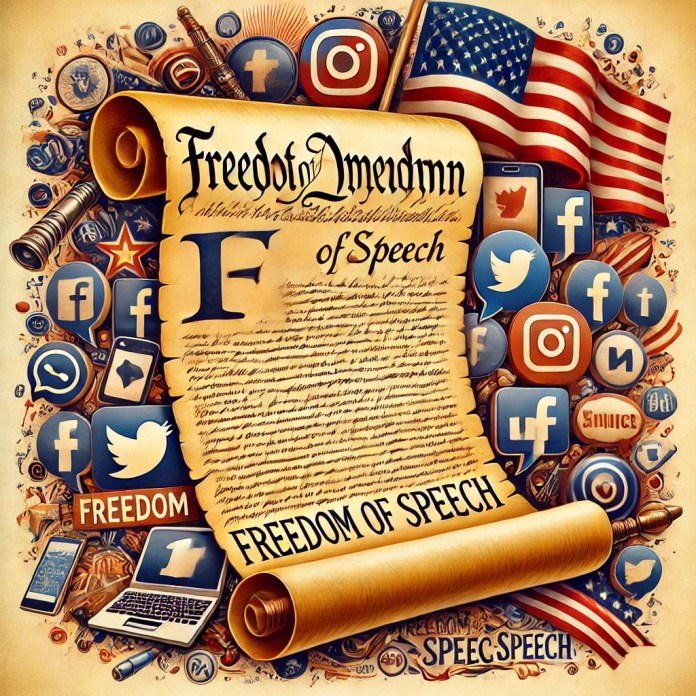Restoring Freedom of Speech and Ending Federal Censorship: What’s at Stake?
 In an era dominated by digital discourse, the government’s role in moderating speech remains a deeply contentious issue. This executive order, issued on January 21, 2025, claims to protect the First Amendment by dismantling alleged federal censorship practices and reshaping the relationship between government agencies and private tech platforms. The stated intent is to restore freedom of speech and accountability while curbing the government’s influence over public discourse. Yet, beneath its surface lies a critical question: whose speech is truly being protected, and at what cost to marginalized voices?
In an era dominated by digital discourse, the government’s role in moderating speech remains a deeply contentious issue. This executive order, issued on January 21, 2025, claims to protect the First Amendment by dismantling alleged federal censorship practices and reshaping the relationship between government agencies and private tech platforms. The stated intent is to restore freedom of speech and accountability while curbing the government’s influence over public discourse. Yet, beneath its surface lies a critical question: whose speech is truly being protected, and at what cost to marginalized voices?
The order’s sweeping measures include a prohibition on federal agencies participating in speech moderation, a retrospective investigation into censorship practices over the last four years, and the elimination of federally supported efforts to combat online misinformation. While it aims to prevent government overreach, the order could fundamentally alter the safeguards that protect against hate speech, misinformation, and coordinated disinformation campaigns. This raises serious concerns about how these changes might impact the safety and inclusivity of digital spaces, particularly for historically underrepresented and vulnerable groups.
At its core, this policy reflects a deeper ideological shift. Framed as a battle for free speech, the order aligns with Project 2025’s broader vision of decentralizing government authority and limiting federal influence in the private sector. However, it also threatens to unravel progress made in addressing online harms and ensuring accountability from major platforms. As Americans grapple with rising political polarization, disinformation, and online harassment, the implications of this order extend far beyond the rhetoric of “freedom”, it reshapes the very infrastructure of our public discourse.
Key Provisions:
- Securing the Right to Free Speech:
- Prohibits federal agencies and officers from engaging in activities that abridge constitutionally protected speech.
- Bars the use of taxpayer resources for speech suppression efforts.
- Investigation of Past Censorship:
- Directs the Attorney General to investigate federal activities related to censorship in the past four years and submit recommendations to address violations.
- Policy Overhaul:
- Mandates federal agencies to ensure all operations comply with the First Amendment.
- Calls for corrective measures against any unconstitutional restrictions discovered during investigations.
Historical Context and Precedent
Relation to Past Policies:
- Biden Administration: Encouraged partnerships with social media platforms to address disinformation during COVID-19 and election cycles, actions this order seeks to undo.
- Trump Administration (2016–2020): Championed free speech narratives but faced criticism for targeting media outlets and platforms that opposed its policies.
- This order redefines the conversation around government involvement in public discourse, reframing federal actions as suppressive.
Broader Policy Context
Connection to Project 2025:
This order aligns closely with Project 2025, particularly its objectives to reduce federal oversight and decentralize power to individuals and private entities. Key excerpts from Project 2025 include:
“The federal government must not dictate the boundaries of public discourse. True freedom depends on uninhibited speech…”
This framing ties into broader ideological goals, such as dismantling federal influence over industries perceived as hostile to conservative ideals (e.g., big tech) and fostering a nationalist approach to governance.
Governance Trends:
- Nationalism: Promotes individual freedoms over collective regulation, a hallmark of the broader administration agenda.
- Deregulation: Limits the federal role in shaping digital speech frameworks, reducing oversight of private platforms.
Predicted Outcomes
Practical Effects:
- Public Discourse:
- Enhanced protections for controversial viewpoints may foster broader debates but could also allow unchecked harmful rhetoric.
- Social media companies may face challenges in moderating content without perceived government influence.
- Economic Impacts:
- Potential changes in the tech industry as platforms navigate reduced federal collaboration.
- Companies reliant on federal contracts for content moderation initiatives may see financial disruptions.
Sector-Specific Predictions:
- Media & Technology: Increased litigation as platforms challenge the scope of this order in their moderation practices.
- Government Agencies: Enhanced scrutiny of past communications between agencies and social media companies.
State and Public Reactions
Legal Challenges (Probability: 100%)
- States like California, Oregon, and New York may challenge this order on grounds of public safety and regulation of online harm.
- Civil rights groups will likely litigate, citing concerns over increased risks of hate speech and misinformation proliferation.
Public Sentiment (Probability: 90%)
- Public opinion is sharply divided, with free speech advocates applauding the order while civil society groups decry potential harm to marginalized communities.
- Urban centers may witness protests against the perceived rollback of safeguards against online abuse.
Interrelated Impacts
Energy of National Debate:
- Amplifies partisan divides over the role of government in regulating speech.
- Sets precedents for how future administrations approach tech regulation.
Cascade Effect Across Policies:
- May influence related executive actions aimed at limiting federal influence, particularly within the Department of Justice or Federal Trade Commission.
Legal and Constitutional Considerations
Challenges Likely Under:
- First Amendment: Critics may argue that while protecting speech, the order undermines efforts to combat misinformation and hate speech.
- Commerce Clause: Potential lawsuits from tech platforms arguing that restrictions interfere with interstate commerce.
Global Implications
- Trade and Tech: International platforms operating in the U.S. may face uncertainties in complying with revised regulations.
- Democratic Ideals: The U.S. risks global criticism for policies that may embolden extremist rhetoric under the guise of free speech.
Data-Driven Analysis
Outcome Predictions:
- Legal Challenges: 100% – Lawsuits expected from states and civil rights groups.
- Public Backlash: 90% – Strong opposition from urban centers, tech workers, and civil rights advocates.
- Economic Disruptions: 70% – Potential uncertainty within the tech sector as companies adjust policies.
- Digital Ecosystem Evolution: 80% – Increased decentralization of moderation may reshape online interactions.
Expanded Probability Estimates with Defined Outcomes
| Outcome | Probability | Details |
|---|---|---|
| Legal Challenges | 100% | Key states like California and New York will likely sue, claiming public safety risks. |
| Public Backlash | 90% | Civil rights groups and marginalized communities may protest reduced protections online. |
| Economic Disruptions | 70% | Federal contract loss may impact tech firms’ operations. |
| Policy Implementation Struggles | 80% | Agencies may face logistical hurdles in enforcing investigations. |
Works Cited
Discover more from Grounded Truth & News Movement
Subscribe to get the latest posts sent to your email.


